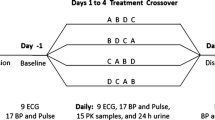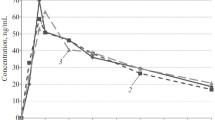Summary
Circadian variation in the serum concentration of theophylline has been reported in most patients receiving slow release oral preparations. To examine further the mechanism and clinical relevance of this change, an investigation has been made into the diurnal fluctuation in elimination kinetics during i.v. administration of theophylline and its serum concentration profile on oral treatment with a slow release preparation, in 8 hospitalized patients receiving it for bronchial obstruction. After reaching steady-state on a constant intravenous infusion, the total body clearance of theophylline (CL) was determined every 4–6 h from the steady-state concentration and the infusion rate. No systematic trend indicative of circadian changes in elimination kinetics was observed. The intraindividual fluctuation in CL during the observation period was small (coefficient of variation 4–11%). In contrast, on oral dosing a smaller area under the serum concentration-time curve was found during the night time (22.00–06.00). The results show that the circadian variation described in serum theophylline concentrations is due to delayed absorption at night. The elimination kinetics of theopyhlline do not change.
Similar content being viewed by others
References
Mitenko PA, Ogilvie RJ (1973) Rational intravenous doses of theophylline. N Engl J Med 289: 600–603
Vozeh S, Kewitz G, Perruchoud A, Tschan M, Kopp C, Heitz M, Follath F (1982) Theophylline serum concentration and therapeutic effect in severe acute bronchial obstruction: The optimal use of intravenously administered aminophylline. Am Rev Respir Dis 126: 181–184
Lesko LJ, Brousseau D, Canada AT, Eastwood G (1980) Temporal variations in trough serum theophylline concentration at steady-state. J Pharm Sci 69: 358–359
Taylor DR, Duffin D, Kinney CD, McDevitt DG (1983) Investigation of diurnal changes in the disposition of theophylline. Br J Clin Pharmacol 16: 413–416
Coulthard KP, Birkett DJ, Lines DR, Grgurinovich N, Grygiel JJ (1983) Bioavailability and diurnal variation in absorption of sustained release theophylline in asthmatic children. Eur J Clin Pharmacol 25: 667–672
Taylor DR, Duffin D, Kinney CD, McDevitt DG (1984) Circadian variation in plasma theophylline concentration during maintenance therapy with a sustained-release preparation in patients with obstructive airways disease. Br J Clin Pharmacol 18: 27–30
Jonkman JHG, von der Boon WJV, Balant LP, Schoenmaker R, Holtkamp A (1984) Chronopharmacokinetics of theophylline after sustained-release and intravenous administration to adults. Eur J Clin Pharmacol 26: 215–222
Scott PH, Tabachnik E, MacLeod S, Correia J, Newth C, Levison H (1981) Sustained-release theophylline for childhood asthma: Evidence for circadian variation of theophylline pharmacokinetics. J Pediatr 99: 476–479
Rowland M, Tozer TN (1980) Clinical pharmacokinetics: concepts and applications. Lea and Febiger, Philadelphia
Author information
Authors and Affiliations
Rights and permissions
About this article
Cite this article
Uematsu, T., Follath, F. & Vozeh, S. Circadian changes in the absorption and elimination of theophylline in patients with bronchial obstruction. Eur J Clin Pharmacol 30, 309–312 (1986). https://doi.org/10.1007/BF00541534
Received:
Accepted:
Issue Date:
DOI: https://doi.org/10.1007/BF00541534




